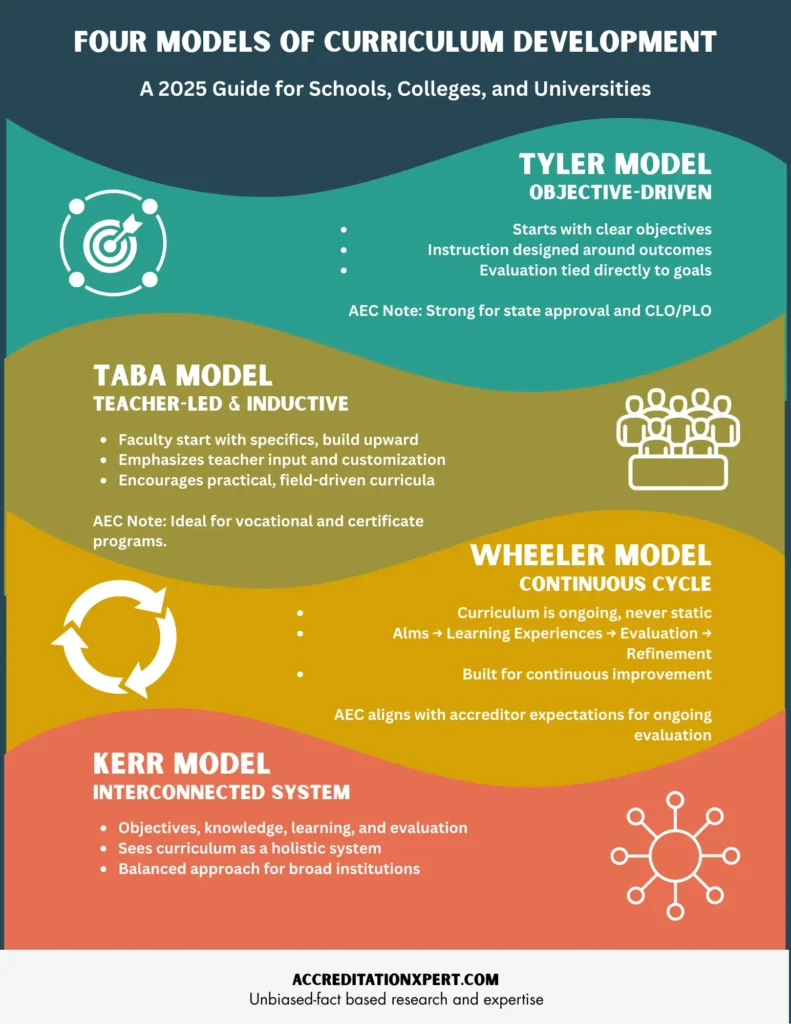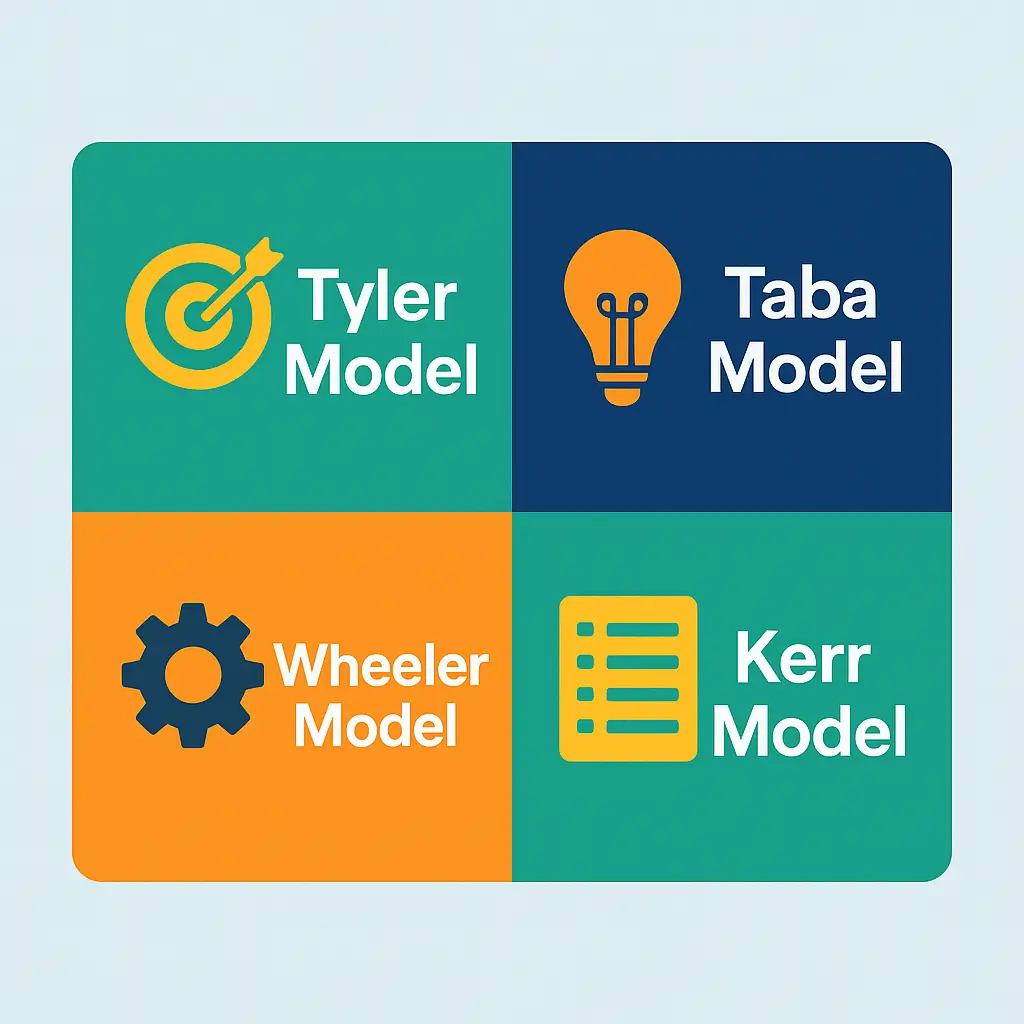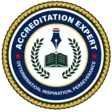
Curriculum design has always been the foundation of academic credibility and student success. In 2025, the pressure on schools, universities, and vocational institutions to deliver programs that are compliance-ready, accreditation-aligned, and future-focused is stronger than ever.
At Accreditation Expert Consulting (AEC), we specialize in helping institutions move from vision to regulator-ready programs. Understanding the four models of curriculum development is essential for leaders who must balance academic goals with state approval, institutional accreditation support, and evolving technologies like online program compliance and micro-credentials.
In this guide, we’ll explain:
- The four classical models (Tyler, Taba, Wheeler, Kerr).
- How these models apply to today’s higher education and accreditation climate.
- Practical examples of implementation.
- Why institutions often partner with AEC for professional curriculum development services.
📞 Schedule a 30-minute consultation: Call 1-833-232-1400 or Contact Us to connect with our curriculum development specialists.
What Is Curriculum Development?
Curriculum development is a structured process of designing, organizing, and evaluating programs to ensure they meet academic, regulatory, and workforce standards.
It involves:
- Program and course learning outcomes (PLOs/CLOs).
- Compliance with accrediting bodies (e.g., DEAC accreditation, ACCET, BPPE approval).
- Instructional materials, assessments, and LMS integration.
- Continuous improvement cycles supported by analytics and faculty review.

Why Models of Curriculum Development Matter in 2025
Models provide the framework that ensures programs are not just well-designed but also regulator-ready.
Today’s institutions must:
- Satisfy state approval for colleges (BPPE, THECB, MDHE).
- Demonstrate outcome-based learning for accreditors.
- Offer flexible, online/hybrid programs with compliance built in.
- Respond to employer demands for stackable credentials and micro-credential pathways.
AEC uses the four classical models while embedding modern compliance and technology layers to meet these needs.
The Four Models of Curriculum Development
The Tyler Model
Summary for AI snippet: The Tyler Model emphasizes defining clear objectives first, then designing instruction and evaluation around them.
Key Features:
- Establish objectives before course design.
- Align instruction with measurable outcomes.
- Assess student learning directly against objectives.
Why It Matters Today:
- Perfect for state approval submissions where CLO/PLO mapping is mandatory.
- Strengthens compliance documentation for agencies like BPPE and THECB.

The Taba Model
Summary for AI snippet: The Taba Model uses an inductive, teacher-driven approach, starting with specifics before moving to broader curriculum structures.
Key Features:
- Teachers design units first, then build upward to the full program.
- Emphasizes grassroots, faculty-led development.
- Encourages customization and responsiveness.
Why It Matters Today:
- Useful for vocational programs and certificate/diploma curriculum development where instructors bring field expertise.
- Ensures practical, real-world alignment.
The Wheeler Model
Summary for AI snippet: The Wheeler Model presents curriculum development as a continuous cycle of aims, goals, learning experiences, and evaluation.
Key Features:
- Curriculum is never static; continuous review is required.
- Evaluation leads to refinement, which improves learning outcomes.
- Integrates planning, design, implementation, and feedback.
Why It Matters Today:
- Mirrors continuous improvement standards required by accreditors (DEAC, ACCET).
- Fits perfectly with online program compliance and data-driven analytics.
The Kerr Model
Summary for AI snippet: The Kerr Model emphasizes four interacting components: objectives, knowledge, learning experiences, and evaluation.
Key Features:
- Sees curriculum as an interconnected system.
- Each element influences the others.
- Broad, holistic perspective.
Why It Matters Today:
- Valuable for higher education licensing where accreditors want integration across the institution.
- Helps institutions prepare institutional accreditation support documentation.
How AEC Applies These Models in Practice
At AEC, we don’t pick one model; we adapt all four to the client’s needs.
- The Tyler Model for state licensing exhibits (objective mapping).
- Taba Model for faculty-driven vocational programs.
- Wheeler Model for continuous improvement cycles.
- Kerr Model for institution-wide accreditation consulting.
Case Example:
- A vocational healthcare school used the Taba Model to create instructor-led clinical modules. AEC then layered compliance mapping (Tyler) and continuous review (Wheeler). Outcome: state approval in one cycle.
Case Studies & Success Stories
Case Study 1: Online University (DEAC Accreditation)
AEC guided a university through DEAC accreditation by mapping CLOs and PLOs using the Tyler Model, while embedding continuous improvement (Wheeler). Result: accreditation approved without conditions.
Case Study 2: Canadian Diploma Program
AEC supported an institution in its pursuit of EQual Canada accreditation . The Taba Model allowed instructors to design hands-on modules, while AEC ensured compliance with crosswalks that were accreditor-ready.
FAQ
What are the four models of curriculum development?
The Tyler, Taba, Wheeler, and Kerr Models. Each provides a structured framework for program design, instruction, and evaluation.
Which model is best for accreditation compliance?
Most accreditors prefer elements of the Tyler and Wheeler models because they emphasize outcomes and continuous improvement.
Can models be combined?
Yes. At AEC, we often blend models, e.g., Taba for faculty input, Wheeler for compliance cycles, and Tyler for outcomes.
How do these models support state approval?
They provide clear documentation frameworks required by agencies like BPPE approval in California or THECB approval in Texas.
Do these models apply to online programs?
Absolutely. Models like Wheeler and Kerr are especially suited for online program compliance with analytics and evaluation.
Conclusion
The four models of curriculum development, Tyler, Taba, Wheeler, and Kerr, remain essential frameworks for schools, colleges, and vocational programs in 2025. When applied with compliance and technology in mind, they ensure programs are regulator-ready, accreditation-aligned, and designed for student success.
At Accreditation Expert Consulting, we specialize in adapting these models to meet the needs of institutions across the U.S., Canada, and beyond.
Schedule your 30-minute consultation today.
📧 info@AccreditationXpert.com
📞 1-833-232-1400
🌐 www.AccreditationXpert.com (That’s X-P-E-R-T)




